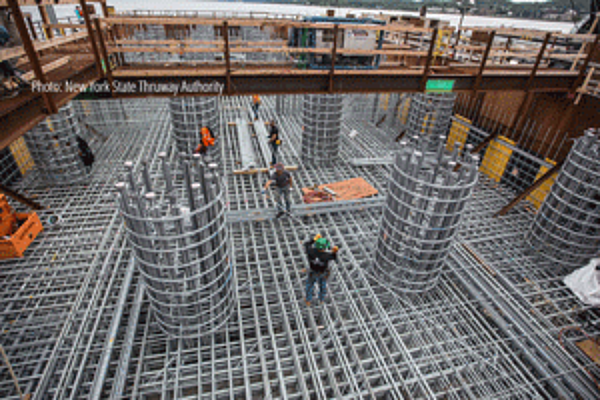ASTM A767 for Reinforcing Steel

The specification ASTM A767/A767M is applicable exclusively to the hot-dip galvanizing of reinforcing steel, otherwise known as rebar (Figure 13), and is applicable to all types of rebar, both smooth and deformed. However, wire is not included.
The requirements in ASTM A767/A767M are also intended to produce a high quality zinc coating for corrosion protection.
ASTM A767/A767M Requirements
- Identity the galvanizer is responsible for consistent material tracking if necessary
- Coating Thickness/Weight material category and steel thickness
- Chromating to prevent reaction between cement and recently galvanized material
- Finish continuous, smooth, and uniform
- Appearance free from uncoated areas, blisters, flux deposits and gross dross inclusions as well as having no heavy zinc deposits that interfere with intended use
- Adherence should be tightly adherent throughout intended use of the product
- Bend Diameters flaking and cracking due to fabrication after the hot-dip galvanizing process are not rejectable
Once rebar is delivered the galvanizing facility, it is the galvanizers responsibility to track and maintain the identity of the product throughout the hot-dip galvanizing process until shipment of the finished product. Again, the analogous coating requirements in the areas of coating thickness, finish, and adherence are present in ASTM A767/A767M. However, this single product specification introduces a few new requirements that apply solely to hot-dip galvanized rebar. In ASTM A767/A767M, the coating requirement is given in mass of the zinc coating per surface area. A summary of the table given in ASTM A767/A767M and the minimum required coating thickness/weight of the classes is seen in Table 4.
Table 4
| Mass (Weight) of Zinc Coating | |
|---|---|
| Coating Class | Mass (Weight) of Zinc Coating min, g/m2 (oz/ft2) of Surface |
| Class I Bar Designation Size No. 10 (3) Bar Designation Size No. 13 (4) or larger |
915 (3.00) 1070 (3.50) |
| Class II Bar Designation Size No. 10 (3) or larger |
610 (2.00) |
This specification also introduces a new requirement to the galvanized coating known as chromating. Newly galvanized steel can react with wet concrete and potentially form hydrogen gas as a product. As this evolved hydrogen gas travels through the concrete matrix toward the surface, voids can be created which weaken the bonding with the concrete or disturb the smoothness of the concrete surface. In order to help prevent and suppress this reaction, hot-dip galvanized rebar is dipped into a dilute chromate quench solution after being removed from the galvanizing kettle.
The finish requirement for rebar is along the same lines as the finish requirements given in specifications ASTM A123/A123M and A153/A153M. The coating is intended for corrosion protection, so deficiencies that affect the coatings corrosion performance are grounds for rejection. In addition, since rebar is handled frequently during its installation, any tears or sharp spikes that make the material dangerous to handle are grounds for rejection.
Rebar is commonly bent prior to the hot-dip galvanizing process. Table 5 (below) gives recommendations for bend diameters based upon the bare steel bar diameter before coating. Steel reinforcing bars bent cold prior to hot-dip galvanizing should be fabricated to a bend diameter equal to or greater than the specified values. However, steel reinforcing bars can be bent to diameters tighter than specified in Table 5 providing they are stress relieved at a temperature of 900 to 1050 F (480 to 560 C) for one hour per inch (25 mm) of diameter.
Table 5
| Minimum Finished Bend Diameters | ||||
|---|---|---|---|---|
| Bar No. | Grade 280 (40) | Grade 350 (50) | Grade 420 (60) | Grade 520 (75) |
| 10, 13, 16, (3, 4, 5) | 6dA | 6 d | 6 d | ... |
| 19 (6) | 6 d | 6 d | 6d | 6d |
| 22, 25, (7,8) | 6d | 8d | 8d | 8d |
| 29, 32 (9,10) | ... | ... | 8d | 8d |
| 36 (11) | ... | ... | 8d | 8d |
| 43, 57 (14, 18) | ... | ... | 10d | 10d |
| Ad = nominal diameter of the bar | ||||